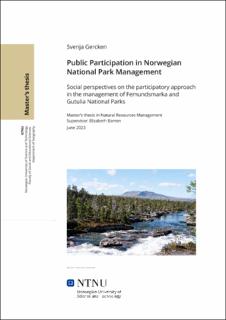| dc.contributor.advisor | Barron, Elizabeth | |
| dc.contributor.author | Gercken, Svenja | |
| dc.date.accessioned | 2023-10-11T17:22:23Z | |
| dc.date.available | 2023-10-11T17:22:23Z | |
| dc.date.issued | 2023 | |
| dc.identifier | no.ntnu:inspera:142264566:97409737 | |
| dc.identifier.uri | https://hdl.handle.net/11250/3095907 | |
| dc.description.abstract | Offentlig medvirkning styrker inkludering av berørte interesser i naturressursforvaltning, og er en måte å tilnærme seg komplekse problemer i større skala fra et helhetlig perspektiv. En vellykket involvering av lokalsamfunn og brukerinteresser i forvaltningen av verneområder reduserer konflikter, gir bedre resultater for bevaring av biologisk mangfold og øker befolkningens tillit i beslutningsprosesser. Det finnes ingen universell fremgangsmåte som forklarer vellykket offentlig medvirkning. Derfor må man tilpasse det til den enkelte kontekst. Norge er et eksempel som kan brukes i en slik kontekst. I 2009, innførte Stortinget en reform for forvaltning av nasjonalparker og andre store verneområder for å støtte lokal og helhetlig forvaltning med fokus på medvirkning.
Denne metodetriangulerte studien undersøkte sosiale perspektiver blant involverte aktører i forvaltningen knyttet til offentlig medvirkning i Femundsmarka og Gutulia nasjonalparker. Fokuset er på offentlig engasjement, spesielt det norske systemet sitt bruk av det rådgivende utvalg i parkforvaltningen. Resultatene viste at det er ulike perspektiver på hvor adekvat og vellykket den nåværende fremgangsmåten er. Gjennom bruk av Q metoden, en kvantitativ og kvalitativ metode for å analysere subjektivitet, ble det identifisert tre perspektiver blant deltagerne i studien. (1) Lokalpolitisk nasjonalparkforvaltning med en god medvirkningstilnærming, (2) Helthetlig lokal nasjonalparkforvaltning med forbedring av medvirkning, og (3) Ekspertbasert lokal nasjonalparkforvaltning. Alle de 13 deltagerne var enige om at det rådgivende utvalget er en møteplass som legger til rette for dialog, diskusjon, kunnskapsutveksling og tillitsbygging. Studien viste at personer som har vært aktive i nasjonalparkforvaltning i minste fire år eller mer, opplever større tilfredshet enn personer som er nye i systemet. I tillegg ble en kvalitativ analyse brukt som identifiserte fordeler og utfordringer for prosesser knyttet til medvirkning i Femundsmarka og Gutulia, samt fremtidige utfordringer for norsk nasjonalparkforvaltning generelt. I tillegg ga studien anbefalinger for forvaltningen knyttet til offentlig medvirkning. Disse anbefalingene var basert på meninger fra forskningsdeltagerne og beste praksis for involvering av interesser i miljøforvaltning. Resultatene fra denne case-studien gjelder kun for den konteksten de oppstår i, og er derfor ikke generaliserbare. | |
| dc.description.abstract | Public participation reinforces the inclusion of affected stakeholders in natural resource management and is a way to approach complex and large-scale environmental problems from a holistic perspective. Successful involvement of the local community and user interests in protected area management reduces conflicts, improves outcomes for the conservation of biodiversity, and increases public trust in decision-making. There is no universal approach to successful participation. Rather good participatory approaches need to be adapted to individual contexts. Norway works in such a context. In 2009, the Norwegian parliament introduced a reform for the management of national parks and other large conservation areas in order to support local and holistic management with a focus on participation.
This mixed methods study explored social perspectives among involved stakeholders on the management related to public participation in Femundsmarka and Gutulia National Parks. The focus is on public engagement, specifically the Norwegian system’s use of advisory committees in park management. Results showed that there are distinct perspectives on how adequate and successful the current approach is. Through the use of the Q method, a quantitative and qualitative method to analyse subjectivity, three perspectives were identified among the study participants: (1) Local political national park management with a good participation approach, (2) Holistic local national park management with improvement of participation, and (3) Expert based local national park management. All 13 participants agreed on the advisory committee being a meeting point which facilitates dialogue, discussion, knowledge exchange and trust building. The study indicated that people who have been active in national park management for a minimum of four years or more experience greater satisfaction compared to people who are new to the system. A companion qualitative analysis identified the advantages and challenges of the participatory approach in Femundsmarka and Gutulia as well as future challenges for Norwegian national park management in general. In addition, the study gave recommendations for management related to public participation. These recommendations were based on opinions of research participants and best practice guidelines for stakeholder involvement in environmental management. Results from this case study apply to the context in which they occur and are therefore not widely generalisable. | |
| dc.language | eng | |
| dc.publisher | NTNU | |
| dc.title | Public Participation in Norwegian National Park Management
Social perspectives on the participatory approach in the management of Femundsmarka and Gutulia National Park | |
| dc.type | Master thesis | |
